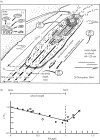The effect of hypoxia on fish schooling
- PMID: 28673914
- PMCID: PMC5498298
- DOI: 10.1098/rstb.2016.0236
The effect of hypoxia on fish schooling
Abstract
Low-oxygen areas are expanding in the oceans as a result of climate change. Work carried out during the past two decades suggests that, in addition to impairing basic physiological functions, hypoxia can also affect fish behaviour. Given that many fish species are known to school, and that schooling is advantageous for their survival, the effect of hypoxia on schooling behaviour may have important ecological consequences. Here, we review the effects of hypoxia on school structure and dynamics, together with the mechanisms that cause an increase in school volume and that ultimately lead to school disruption. Furthermore, the effect of hypoxia generates a number of trade-offs in terms of schooling positions and school structure. Field observations have found that large schools of fish can exacerbate hypoxic conditions, with potential consequences for school structure and size. Therefore, previous models that predict the maximum size attainable by fish schools in relation to oxygen levels are also reviewed. Finally, we suggest that studies on the effect of hypoxia on schooling need to be integrated with those on temperature and ocean acidifications within a framework aimed at increasing our ability to predict the effect of multiple stressors of climate change on fish behaviour.This article is part of the themed issue 'Physiological determinants of social behaviour in animals'.
Keywords: climate change; environmental stressor; fish behaviour; fish physiology; group behaviour; group living.
© 2017 The Author(s).
Conflict of interest statement
We declare we have no competing interests.
Figures





Similar articles
-
The effect of progressive hypoxia on school structure and dynamics in Atlantic herring Clupea harengus.Proc Biol Sci. 2002 Oct 22;269(1505):2103-11. doi: 10.1098/rspb.2002.2107. Proc Biol Sci. 2002. PMID: 12396484 Free PMC article.
-
Hypoxia and the antipredator behaviours of fishes.Philos Trans R Soc Lond B Biol Sci. 2007 Nov 29;362(1487):2105-21. doi: 10.1098/rstb.2007.2103. Philos Trans R Soc Lond B Biol Sci. 2007. PMID: 17472921 Free PMC article. Review.
-
Bioluminescent flashes drive nighttime schooling behavior and synchronized swimming dynamics in flashlight fish.PLoS One. 2019 Aug 14;14(8):e0219852. doi: 10.1371/journal.pone.0219852. eCollection 2019. PLoS One. 2019. PMID: 31412054 Free PMC article.
-
Physiological and ecological implications of ocean deoxygenation for vision in marine organisms.Philos Trans A Math Phys Eng Sci. 2017 Sep 13;375(2102):20160322. doi: 10.1098/rsta.2016.0322. Philos Trans A Math Phys Eng Sci. 2017. PMID: 28784712 Free PMC article. Review.
-
Climate change and dead zones.Glob Chang Biol. 2015 Apr;21(4):1395-406. doi: 10.1111/gcb.12754. Epub 2014 Nov 10. Glob Chang Biol. 2015. PMID: 25385668 Review.
Cited by
-
Increased water temperature and turbidity act independently to alter social behavior in guppies (Poecilia reticulata).Ecol Evol. 2023 Mar 28;13(3):e9958. doi: 10.1002/ece3.9958. eCollection 2023 Mar. Ecol Evol. 2023. PMID: 37006888 Free PMC article.
-
Acute Exposure to key Aquaculture Environmental Stressors Impaired the Aerobic Metabolism of Carassius auratus gibelio.Biology (Basel). 2020 Feb 10;9(2):27. doi: 10.3390/biology9020027. Biology (Basel). 2020. PMID: 32050708 Free PMC article.
-
The role of physiological traits in assortment among and within fish shoals.Philos Trans R Soc Lond B Biol Sci. 2017 Aug 19;372(1727):20160233. doi: 10.1098/rstb.2016.0233. Philos Trans R Soc Lond B Biol Sci. 2017. PMID: 28673911 Free PMC article. Review.
-
Social dynamics obscure the effect of temperature on air breathing in Corydoras catfish.J Exp Biol. 2020 Nov 12;223(Pt 21):jeb222133. doi: 10.1242/jeb.222133. J Exp Biol. 2020. PMID: 33097572 Free PMC article.
-
Oil exposure alters social group cohesion in fish.Sci Rep. 2019 Sep 18;9(1):13520. doi: 10.1038/s41598-019-49994-1. Sci Rep. 2019. PMID: 31534177 Free PMC article.
References
-
- Druon J-N, Schrimpf W, Dobricic S, Stips A. 2004. Comparative assessment of large-scale marine eutrophication: North Sea area and Adriatic Sea as case studies. Mar. Ecol. Prog. Ser. 272, 1–23. (10.3354/meps272001) - DOI
-
- Hagy JD, Boynton WR, Keefe CW, Wood KV. 2004. Hypoxia in Chesapeake Bay 1950–2001: long-term change in relation to nutrient loading and river flow. Estuaries 27, 634–658. (10.1007/BF02907650) - DOI
-
- Chapman LJ, McKenzie DJ. 2009. Behavioral responses and ecological consequences. In Hypoxia (eds Richards JG, Farrell AP, Brauner CJ), pp. 25–77. San Diego, CA, USA: Elsevier.
Publication types
MeSH terms
Substances
LinkOut - more resources
Full Text Sources
Other Literature Sources
Miscellaneous

